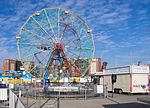Tornado (Coney Island)
Amusement ride stubsConey IslandDemolished buildings and structures in BrooklynFormer roller coasters in New York (state)Removed roller coasters ... and 3 more
Roller coasters introduced in 1926Roller coasters that closed in 1977Wooden roller coasters

Tornado (formerly known as Bobs) was a roller coaster located at Coney Island along Bowery Street in Brooklyn, New York City. Designed by Fred Church and built by the L. A. Thompson Company, the roller coaster cost $250,000 to build and opened in 1926. Much like the neighboring Coney Island Cyclone, it was a hybrid design consisting of a wooden track and steel structure. The coaster's track wrapped around a tower atop which the ride's name was attached. The land under the coaster was narrow, only 70 feet wide at its widest.In 1977, much of the coaster was destroyed by arson. The coaster was completely demolished in April 1978.
Excerpt from the Wikipedia article Tornado (Coney Island) (License: CC BY-SA 3.0, Authors, Images).Tornado (Coney Island)
West 12th Street, New York Brooklyn
Geographical coordinates (GPS) Address Phone number Website Nearby Places Show on map
Geographical coordinates (GPS)
| Latitude | Longitude |
|---|---|
| N 40.574 ° | E -73.979 ° |
Address
Deno's Wonder Wheel Amusement Park
West 12th Street 3059
11224 New York, Brooklyn
New York, United States
Open on Google Maps









